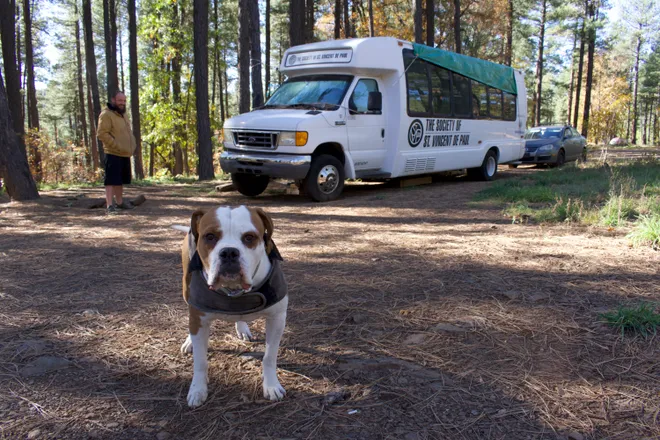By Juliette Rihl | Arizona Republic
 Morgan Rice and his dog, Rio, stand outside of Rice’s van in Coconino National Forest.
Morgan Rice and his dog, Rio, stand outside of Rice’s van in Coconino National Forest.
Rice and his girlfriend have called the van home since August. Juliette Rihl/The Republic
For the past few months, Morgan Rice has called Coconino National Forest home.
Rice and his girlfriend — along with their dog, Rio, and their cat, Kit — have been camping full-time in their 32-foot, 2006 Ford diesel van since August. When monthly rent for their one-bedroom apartment in Avondale increased from around $800 to over $1,300, the couple simply couldn’t keep up.
“They outpriced us,” Rice said.
So they traded in their Jeep, bought the van and hit the road.
As housing in Arizona and across the nation becomes increasingly unaffordable, more people are flocking to the forest and setting up camp on public lands — for good. To some, living off the grid is a lifestyle choice. For others, it’s a last resort. Average rents in some parts of Arizona have increased by as much as 30% or 40% since 2020, pushing many people out.
The growing trend is, in part, a side effect of the state’s deepening housing crisis. It’s also raising concerns about the potential impacts on the state’s protected lands and nearby communities.
In the wake of this year’s destructive wildfire season, the influx of campers has some northern Arizona residents and forest officials on edge. While many campers are careful and respectful of the land, a stray cigarette butt or dinnertime campfire could set the forest ablaze. The Pipeline Fire, which tore through more than 25,000 acres just several miles north of Flagstaff in June, was started by a 57-year-old man who burned toilet paper and put it under a rock.
Long-term camping poses other challenges as well. Garbage needs to be collected, and the campers need to be checked on for their own safety.
But for some people who have recently started living on public lands, trading in unaffordable rents for a more cost-effective and adventurous lifestyle has been worth it.
For Rice, van life isn’t perfect. Moving every few weeks can be a pain, and he has to drive almost an hour to his job in Sedona. But his van has everything he needs, including a TV, a queen mattress, two kayaks and a spice rack. He and his girlfriend make a point of keeping it clean and even participated in a forest clean-up in the fall.
All in all, he doesn’t miss apartment life.
“We’ve got a great view of the stars,” he said. “Don’t have any noisy neighbors.”
A long-term camper, also called a “nonrecreational camper” by academics and forest officials, is anyone who camps longer than the two-week limit in place on most public lands. This category includes everyone from people experiencing homelessness or trying to escape rising rents to retirees in RVs and free spirits living off the grid.
The idea isn’t new. Research shows people have taken refuge on public lands since the Great Depression. In 1992, the National Forest Service even set up an Oregon campground exclusively for people experiencing homelessness.
Because long-term campers are transient and can be difficult to find, there is no reliable data on how many of them exist. But experts agree that the trend is on the rise.
In late October, The Arizona Republic spoke to more than half a dozen campers living in the Coconino National Forest near Flagstaff.
For some, the decision to move to the forest was easy.
“Homes are terrible, and they cost too much. Might as well live in a trailer,” said Shaun Ylatupa-McWhorter, a remote tech worker. After rent for his two-bedroom apartment in central Phoenix increased to $1,800, he bought a 24-foot trailer, outfitted it with solar power and a few stand-up desks and moved to the woods in the summer of 2022. He spends his free time biking, rock climbing and composing music on modular synthesizers.
Nearby, Chelsea Henning lives with her boyfriend and their dog, Kaya, in a renovated yellow school bus nestled among evergreen trees. Henning, who cleans houses in Flagstaff, said she’s always wanted to live off-grid. When her rent there increased, she made the leap. The bus was about $10,000 after renovations, she said.
“The opportunity came up, and I just jumped on it,” said Henning, who still travels into town each day for work.
For other people, camping is a last resort. Pamela Karr-Wiseman and Daniel Wiseman lost their jobs during the pandemic and were soon evicted. For the past two years, the couple has been living in tents off of a dirt road deep in the forest.
“I always worked,” Karr-Wiseman said. “I’ve established lives, households, lifestyles more than once in my life. And to have it happen this time, again — I’m getting old, and it’s kind of crushing.”
Read more (subscriber content)
Some stories may only appear as partial reprints because of publisher restrictions.
